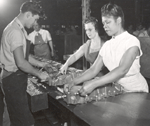
Student & Teacher Resources
An Economic 'Frankenstein'
1. What did Alfred Granakis mean when he referred to automation as “an economic ‘Frankenstein’”?
2. How does Meyer differentiate his study of workers’ relationship to automation from the approaches of other scholars who have examined this issue?
3. What was the impact of automation on assembly-line production workers and skilled maintenance workers at Brook Park, in terms of both the numbers of each type of worker and the nature of the work that each type did? What was the impact on “the social composition of the factory workforce”?
4. Why did the local union at Brook Park engage in so many, seemingly petty disputes with plant officials about production standards, wage rates, job tasks, and job classifications? Were these disputes trivial, in Meyer’s view?
5. How did the actions of workers at Ford’s River Rouge Plant influence the company’s decision to build the automated facilities at Brook Park?
6. Why would automation improve the speed and efficiency of production, and reduce the power and control of workers over the production process?
7. Meyer writes that automation-related disputes at Brook Park over “production standards, speed-up, wage rates, and job classifications . . . plague[d] workers’ shop-floor relations with foremen, supervisors, and managers for several years.” How did each of these issues damage labor-management relations at Brook Park? Be sure to cite and explain the significance of some of the specific examples Meyer provides.
8. Meyer describes UAW Local 1250 President Granakis’s interactions not only with Ford officials but with national UAW leaders. How would you characterize those interactions between Granakis and national leaders like UAW President Walter Reuther?
9. Why did national UAW leaders not want Local 1250 to strike at Brook Park? Why did workers there go on wildcat strikes anyway?
10. What does Meyer see as the results of the introduction of automation for workers? How did the UAW ultimately decide to respond to automation?
1. If a group of workers at your workplace staged a wildcat strike, would you join them even if you disagreed with their grievances and goals? Would you refrain from joining them even if you did?
2. Should a company do anything for workers it lays off due to the introduction of new machinery?
3. How important is workers’ right to strike? A company’s ability to bring in replacement workers during a strike? An individual worker’s ability to choose whether or not to join a union?
1. Meyer notes that his account of the introduction of automation at Ford differs from that offered by Thomas Sugrue in his book, The Origins of the Urban Crisis. Sugrue briefly summarizes that argument here, in the “Moving Out” section of his essay. How does Meyer’s account differ from Sugrue’s? In what ways, if any, is it similar?
2. David Gartman and Margaret Walsh both characterize the years from 1945 to 1960 as a period of tremendous economic and consumer expansion, with American workers fully participating in that prosperity in unprecedented numbers. Meyer shows, however, that workers and union officials in this period feared that automation would undermine that prosperity, especially for the working class. How so?
3. The Brook Park Plant produced engines, and clearly Ford wanted to build those engines as rapidly and with as little labor as possible. Based on the discussions of the auto industry in the 1950s by David Gartman and Martin Melosi, how concerned did Ford seem to be with engineering those engines, and the cars they went in, to be as energy-efficient and non-polluting as possible? What factors contributed to that concern, or lack of concern?
1. At the end of his Introduction, Meyer writes that automation “transformed deep-rooted shop traditions, such as the social structures and social relations of work and the privileged nature and carefully defended boundaries of the skilled trades.” Explain in your own words how automation did these things.
2. Meyer alludes in his Introduction and Conclusion to a debate within the UAW during the 1950s and 60s about whether to bargain with automakers for higher wages and better income security, or shorter work hours and more leisure time. What are the pros and cons of each position? If you were a worker, which would you prefer, and why?
1. Meyer refers to the “Treaty of Detroit,” the five-year contract that Walter Reuther and the UAW negotiated with the Big Three automakers in 1950. Learn more about this famous “treaty.” How did it come about? What made it so significant? What was new about it? How satisfied were both sides with it? Was it popular with UAW members, or did Reuther and other union leaders have to “sell” it to their membership? What was the impact, both short- and long-term, of this contract? Was it something that either side came to regret?
2. What is the current state of automation in the automobile industry? How extensively is automation, including robots, used? For what tasks? What effect has automation had on the number of jobs, production costs, productivity, etc.?
3. Investigate the most recent contract between the UAW and the Big Three. What were the central issues? Did they include automation and any of the related issues (production standards, wage rates, job tasks, job classifications) in dispute at Brook Park in the 1950s? How were they resolved? Were the negotiations contentious or smooth?
For other Resources on Labor see:
An Economic 'Frankenstein'
About the Project | Credits | Contact Us | Student & Teacher Resources | Site Map
©2004-2010 Automobile in American Life and Society
